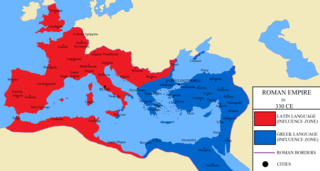
In linguistics, the comparative method is a technique for studying the development of languages by performing a feature-by-feature comparison of two or more languages with common descent from a shared ancestor and then extrapolating backwards to infer the properties of that ancestor. The comparative method may be contrasted with the method of internal reconstruction in which the internal development of a single language is inferred by the analysis of features within that language. Ordinarily, both methods are used together to reconstruct prehistoric phases of languages; to fill in gaps in the historical record of a language; to discover the development of phonological, morphological and other linguistic systems and to confirm or to refute hypothesised relationships between languages.

The Italic languages form a branch of the Indo-European language family, whose earliest known members were spoken on the Italian Peninsula in the first millennium BC. The most important of the ancient languages was Latin, the official language of ancient Rome, which conquered the other Italic peoples before the common era. The other Italic languages became extinct in the first centuries AD as their speakers were assimilated into the Roman Empire and shifted to some form of Latin. Between the third and eighth centuries AD, Vulgar Latin diversified into the Romance languages, which are the only Italic languages natively spoken today, while Literary Latin also survived.

Latin phonology is the system of sounds used in various kinds of Latin. This article largely deals with what features can be deduced for Classical Latin as it was spoken by the educated from the late Roman Republic to the early Empire. Evidence comes in the form of comments from Roman grammarians, common spelling mistakes, transcriptions into other languages, and the outcomes of various sounds in Romance.

The Romance languages, also known as the Latin or Neo-Latin languages, are the languages that are directly descended from Vulgar Latin. They are the only extant subgroup of the Italic branch of the Indo-European language family.

The Tocharianlanguages, also known as Arśi-Kuči, Agnean-Kuchean or Kuchean-Agnean, are an extinct branch of the Indo-European language family spoken by inhabitants of the Tarim Basin, the Tocharians. The languages are known from manuscripts dating from the 5th to the 8th century AD, which were found in oasis cities on the northern edge of the Tarim Basin and the Lop Desert. The discovery of these languages in the early 20th century contradicted the formerly prevalent idea of an east–west division of the Indo-European language family as centum and satem languages, and prompted reinvigorated study of the Indo-European family. Scholars studying these manuscripts in the early 20th century identified their authors with the Tokharoi, a name used in ancient sources for people of Bactria (Tokharistan). Although this identification is now believed to be mistaken, "Tocharian" remains the usual term for these languages.

Vulgar Latin, also known as Popular or Colloquial Latin, is the range of non-formal registers of Latin spoken from the Late Roman Republic onward. Vulgar Latin as a term is both controversial and imprecise. Spoken Latin existed for a long time and in many places. Scholars have differed in opinion as to the extent of the differences, and whether Vulgar Latin was in some sense a different language. This was developed as a theory in the nineteenth century by Raynouard. At its extreme, the theory suggested that the written register formed an elite language distinct from common speech, but this is now rejected.
Metathesis is the transposition of sounds or syllables in a word or of words in a sentence. Most commonly, it refers to the interchange of two or more contiguous segments or syllables, known as adjacent metathesis or local metathesis:

The Russian alphabet is the script used to write the Russian language. It comes from the Cyrillic script, which was devised in the 9th century for the first Slavic literary language, Old Slavonic. Initially an old variant of the Bulgarian alphabet, it became used in the Kievan Rusʹ since the 10th century to write what would become the modern Russian language.

Old Latin, also known as Early Latin or Archaic Latin, was the Latin language in the period before 75 BC, i.e. before the age of Classical Latin. It descends from a common Proto-Italic language; Latino-Faliscan is likely a separate branch from Osco-Umbrian with possible further relation to other Italic languages and to Celtic; e.g. the Italo-Celtic hypothesis.
Assimilation is a sound change in which some phonemes change to become more similar to other nearby sounds. A common type of phonological process across languages, assimilation can occur either within a word or between words.
Since the early 16th century, Nahuatl has been written in an orthography in Latin script based on Spanish spelling conventions, with overall the same values for letters in both orthographies. Over the centuries, Latin script was utilized to record a large body of Nahuatl prose and poetry, which somewhat mitigated the devastating loss of the thousands of Aztec manuscripts that were burned by Spanish missionaries.
Ancient Greek phonology is the reconstructed phonology or pronunciation of Ancient Greek. This article mostly deals with the pronunciation of the standard Attic dialect of the fifth century BC, used by Plato and other Classical Greek writers, and touches on other dialects spoken at the same time or earlier. The pronunciation of Ancient Greek is not known from direct observation, but determined from other types of evidence. Some details regarding the pronunciation of Attic Greek and other Ancient Greek dialects are unknown, but it is generally agreed that Attic Greek had certain features not present in English or Modern Greek, such as a three-way distinction between voiced, voiceless, and aspirated stops ; a distinction between single and double consonants and short and long vowels in most positions in a word; and a word accent that involved pitch.

Latin is a member of the broad family of Italic languages. Its alphabet, the Latin alphabet, emerged from the Old Italic alphabets, which in turn were derived from the Etruscan, Greek and Phoenician scripts. Historical Latin came from the prehistoric language of the Latium region, specifically around the River Tiber, where Roman civilization first developed. How and when Latin came to be spoken has long been debated.

Proto-Albanian is the ancestral reconstructed language of Albanian, before the Gheg–Tosk dialectal diversification. Albanoid and other Paleo-Balkan languages had their formative core in the Balkans after the Indo-European migrations in the region. Whether descendants or sister languages of what was called Illyrian by classical sources, Albanian and Messapic, on the basis of shared features and innovations, are grouped together in a common branch in the current phylogenetic classification of the Indo-European language family. The precursor of Albanian can be considered a completely formed independent IE language since at least the first millennium BCE, with the beginning of the early Proto-Albanian phase.

The language known today as Spanish is derived from spoken Latin, which was brought to the Iberian Peninsula by the Romans after their occupation of the peninsula that started in the late 3rd century BC. Today it is the world's 4th most widely spoken language, after English, Mandarin Chinese and Hindi. Influenced by the peninsular hegemony of Al-Andalus in the early middle ages, Hispano-Romance varieties borrowed substantial lexicon from Arabic. Upon the southward territorial expansion of the Kingdom of Castile, Hispano-Romance norms associated to this polity displaced both Arabic and the Mozarabic romance varieties in the conquered territories, even though the resulting speech also assimilated features from the latter in the process. The first standard written norm of Spanish was brought forward in the 13th century by Alfonso X the Wise, probably drawing from the speech of the upper classes of Toledo. Features associated with the Castilian patterns of Hispano-Romance also spread west and east to the kingdoms of León and Aragón for the rest of the middle ages, owing to the political prestige achieved by the Kingdom of Castile in the peninsular context and to the lesser literary development of their vernacular norms. From the 1560s onward the standard written form followed Madrid's.
In historical linguistics, phonological change is any sound change that alters the distribution of phonemes in a language. In other words, a language develops a new system of oppositions among its phonemes. Old contrasts may disappear, new ones may emerge, or they may simply be rearranged. Sound change may be an impetus for changes in the phonological structures of a language. One process of phonological change is rephonemicization, in which the distribution of phonemes changes by either addition of new phonemes or a reorganization of existing phonemes. Mergers and splits are types of rephonemicization and are discussed further below.
As Classical Latin developed into Proto-Romance, its lexicon underwent numerous changes.
The Reichenau Glossary is a collection of Latin glosses likely compiled in the 8th century in northern France to assist local clergy in understanding certain words or expressions found in the Vulgate Bible.
As a member of the dialect continuum of Romance languages, Catalan displays linguistic features similar to those of its closest neighbors. The following features represent in some cases unique changes in the evolution of Catalan from Vulgar Latin; other features are common in other Romance-speaking areas.
Proto-Romance is the comparatively reconstructed ancestor of the Romance languages. It is effectively Late Latin viewed retrospectively through its descendants.











